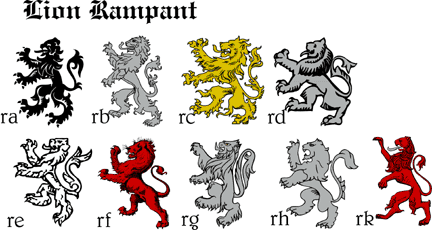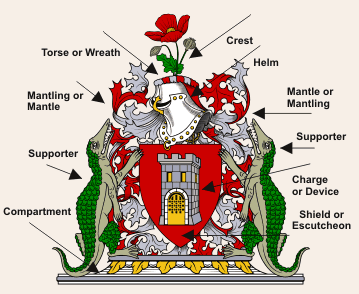
There is a temptation for many family historians to want to lay claim to a Coat of Arms for their family name. However an understanding of Heraldry and its rules of application are necessary before any such usage can be correctly made.
Heraldry began in the 12th century, probably in response to the wearing of helmets with armour, which made recognition of leaders more difficult. Use of a coat of arms on a banner, shield or coat made distinguishing between men in armour possible. Heraldic bearings became hereditary as the son of the original feudal lord retained the original pattern to guide his followers into battle.
Coats of Arms can be found in many European countries, including Poland, Hungary, France and Germany. However the information below applies largely to Great Britain. Rules of heraldry vary between countries.
Armorial bearings usually belong to an individual, and usually may rightfully be used by the male-line descendants of the individual to whom they were granted or first allowed. In this way, not everyone with a particular surname can lay claim to the use of a coat of arms. It is necessary to trace one's male-line ancestry back as far as possible and then examine the official records of the heraldic authority concerned.
Prior to the 16th century heraldry was unregulated in England. In the early 16th century, Henry VIII became the first to formalise things by sending out his heralds to create lists by visitations to members of the gentry and nobility throughout the shires of England. By the 17th century, the Law of Arms had evolved to the point where only arms granted or confirmed by visitation were lawful.
The authority on heraldic grants, (they can still be granted today) for:
No complete list of families granted arms in England prior to 1687 exists.
However the State Library holds several excellent resources for Heraldry, including the Harleian collection. One of the earliest indexes is found in Grantees of Arms (Harleian Society, vol.66, 1915). The Harleian collection also has copies of some of the pedigrees (family trees) collected by visiting heralds from the College of Arms in London to noble families claiming arms. (for example Visitations of Hertfordshire 1634). This information was needed to substantiate future claims. From 1687-1898 most persons granted arms are listed in Grantees of Arms II (Harleian Society, vols.67 &68. 1916-17). These do not describe the arms granted.
For more details on this collection choose the tab above entitles Harleian Collection.

Various examples of the Lion Rampant. This symbol was used to indicate great courage or valour. Could also be uses as a symbol of a great warrior or chief.

Above are just a few basic descriptors of items you may find on a coat of arms
The Library holds an extensive collection of books on heraldry. These can be found by searching under the subject Heraldry in the Library's catalogue database.
The books listed below may help trace a Coat of Arms or explain what the symbols, colours and markings mean.
The websites below give general background to the history of heraldry as well as explain the meaning and symbolism behind the various items that make up a coat of arms: